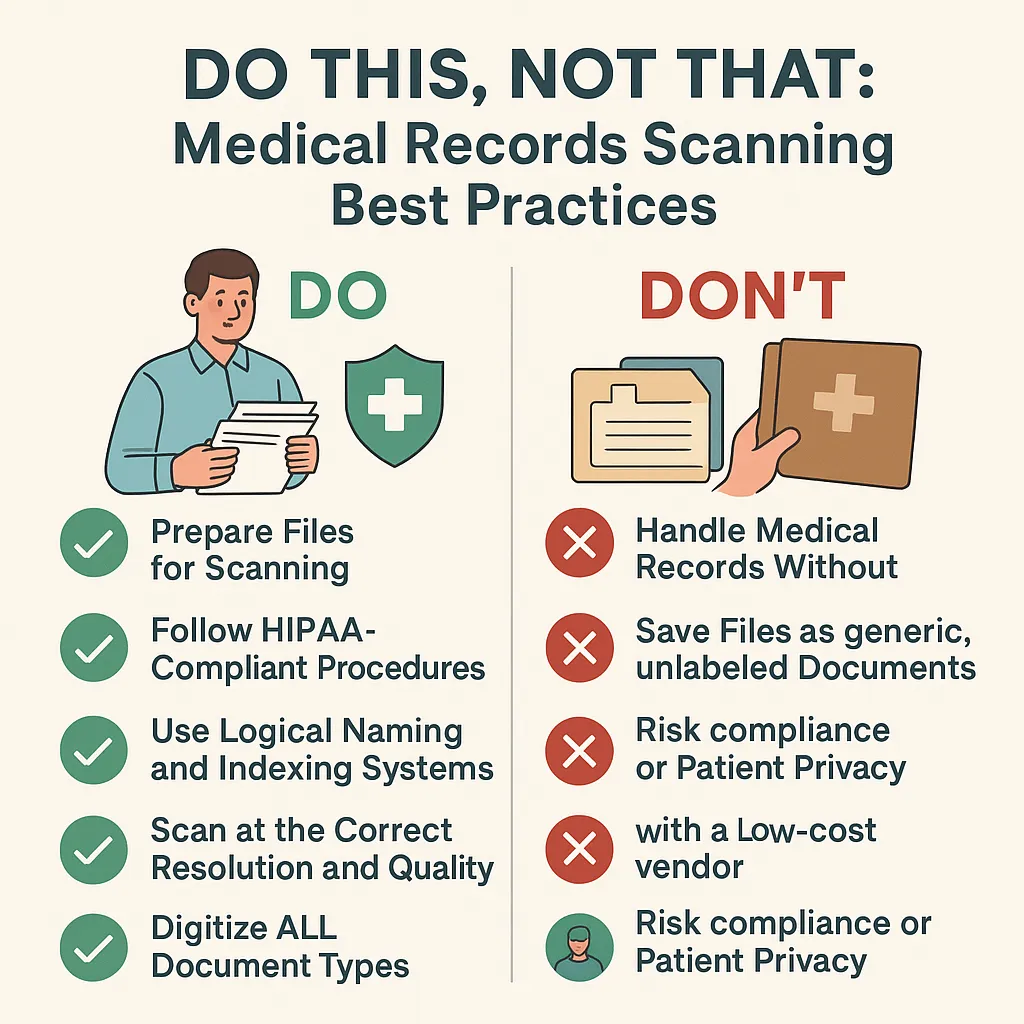
Do This, Not That: Medical Records Scanning Best Practices
By USA IMAGING, Inc.
Medical records are among the most sensitive and regulated documents in any organization. From HIPAA compliance to patient confidentiality, scanning and digitizing these files requires much more than just a quick pass through a scanner. At USA IMAGING, Inc., we specialize in secure, high-quality medical record scanning—and we’ve seen firsthand what separates a successful digital transformation from a chaotic one.
Here’s our “Do This, Not That” guide to medical records scanning that ensures safety, accuracy, and compliance from start to finish.
✅ DO: Prepare Files for Scanning
❌ DON'T: Drop unorganized, stapled, or damaged records into the scanning queue.
Proper preparation is critical. Remove staples, repair torn pages, and ensure documents are sorted by patient, date, or visit type. Improper prep results in missed pages, out-of-order files, and scanning delays.
✅ DO: Follow HIPAA-Compliant Procedures
❌ DON'T: Handle medical records without secure protocols.
All stages of the scanning process—from pickup to digital delivery—must follow HIPAA guidelines. At USA IMAGING, Inc., our staff is HIPAA-trained, our equipment is secure, and our process includes audit trails, access controls, and encryption for total compliance.
✅ DO: Use Logical Naming and Indexing Systems
❌ DON'T: Save files as generic, unlabeled documents.
Medical records should be indexed in a way that mirrors your EMR or chart system—by patient name, ID, date of service, or department. We work with clinics and hospitals to customize folder structures and naming conventions for easy digital retrieval.
✅ DO: Scan at the Correct Resolution and Quality
❌ DON'T: Use low-quality scanning settings or automatic compression.
We recommend 300 DPI for all medical records—this ensures crisp text, legible handwriting, and accurate OCR. Compression settings are carefully calibrated so files remain readable while minimizing storage use.
✅ DO: Apply OCR for Searchability
❌ DON'T: Create image-only PDFs with no searchable text.
Optical Character Recognition (OCR) makes your records text-searchable—saving time and improving care by enabling keyword searches in scanned files. This is especially useful for physician notes, test results, and referral letters.
✅ DO: Digitize ALL Document Types
❌ DON'T: Leave out specialty records or non-standard pages.
X-rays, lab slips, color-coded forms, ID cards—each must be digitized carefully. USA IMAGING, Inc. is equipped to handle non-standard sizes and materials so your digital files are complete and usable.
✅ DO: Maintain Original Document Integrity
❌ DON'T: Return documents in disarray.
After scanning, we return physical records in the same condition—or better—than we received them. Documents are neatly reassembled, restapled if needed, and boxed by patient or chart group.
✅ DO: Work with a Trusted Medical Scanning Partner
❌ DON'T: Risk compliance or patient privacy with a low-cost vendor.
Medical records aren’t just paper—they’re legally protected health information (PHI). USA IMAGING, Inc. has over two decades of experience handling sensitive medical files for hospitals, clinics, private practices, and military agencies. Your trust is earned through professionalism, precision, and proven compliance.
Final Thoughts
The transition from paper to digital in the healthcare field isn’t just about convenience—it’s about compliance, quality of care, and operational efficiency. Done right, it reduces risk, saves space, and streamlines patient access to care.
At USA IMAGING, Inc., we don't just scan—we secure, index, and protect your patient data with the highest standards in the industry.
📞 Reach out to USA IMAGING, Inc. today to discuss your medical record scanning needs—and make sure it’s done right, from prep to archive.
